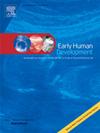Perinatal factors associated with sensory processing difficulties in infancy: Findings from the Etude Longitudinale Francaise depuis l'Enfance (ELFE) French national birth cohort
IF 2.2
3区 医学
Q2 OBSTETRICS & GYNECOLOGY
引用次数: 0
Abstract
Background
Sensory processing involves the nervous system receiving, modulating, and responding to sensory stimuli. Clinical samples have elevated rates of sensory processing difficulties, less is known about sensory processing at population-level. We aimed to investigate patterns of sensory processing in infancy and their association with perinatal factors.
Methods
Data from a French prospective birth cohort of 9861 babies were used to identify latent sensory classes of 1-year-olds. Multinomial logistic regression examined whether sex, cumulative sociodemographic risk or perinatal factors, were associated with these classes.
Results
Three classes, ‘typical sensory’ (71.2 %), ‘definite sensory difficulties’ (21.3 %) and a ‘possible sensory difficulties’ group (7.5 %) best fit the data. The ‘typical’ group were easy to calm, adaptable, had low anxiety with no feeding concerns. The ‘definite’ group were the least easy to calm, least accepting of confined spaces, least adaptable and most anxious. They exhibited more sleeping and feeding problems. The ‘possible’ group were similar to the ‘typical’ group apart from being less adaptable with increased sleep difficulties. Dose-response relationships were observed between low 1.5 (relative risk ratio (RRR) CI 1.3–1.9), moderate 2.3 (CI 1.9–2.7) and high 3.5 (CI 2.6–4.8) sociodemographic risk and increasing number of pregnancy-specific adverse experiences:1.5 (CI 1.2–1.9), 1.9 (CI 1.5–2.5), 2.1 (CI 1.6–2.9), 2.4 (CI 1.6–3.6), 3.0 (CI 1.7–5.3) with an increasing risk of sensory difficulties.
Conclusions
Using public and patient involvement to guide sensory indicator selection for latent class analyses we found that post-natal sociodemographic risk and adverse pregnancy-specific experiences were most strongly associated with sensory difficulties in infants.
与婴儿期感觉处理障碍有关的围产期因素:法国全国出生队列纵向调查(ELFE)的结果
背景感觉处理涉及神经系统对感觉刺激的接收、调节和反应。临床样本中感觉处理障碍的发生率较高,但对人群中的感觉处理却知之甚少。我们的目的是研究婴儿期感觉处理的模式及其与围产期因素的关系。方法:我们利用法国前瞻性出生队列中 9861 名婴儿的数据来识别 1 岁婴儿的潜在感觉类别。结果三个类别:"典型感官 "组(71.2%)、"明确感官障碍 "组(21.3%)和 "可能感官障碍 "组(7.5%)最符合数据。典型 "组易于安抚,适应能力强,焦虑程度低,不担心喂养问题。而 "确定 "组的孩子最不容易平静下来,最不容易接受密闭空间,适应能力最差,焦虑程度最高。他们表现出更多的睡眠和喂养问题。可能 "组与 "典型 "组相似,但适应能力较差,睡眠困难增加。结论通过公众和患者的参与来指导潜类分析中感官指标的选择,我们发现产后社会人口风险和特定妊娠的不良经历与婴儿感官障碍的关系最为密切。
本文章由计算机程序翻译,如有差异,请以英文原文为准。
求助全文
约1分钟内获得全文
求助全文
来源期刊

Early human development
医学-妇产科学
CiteScore
4.40
自引率
4.00%
发文量
100
审稿时长
46 days
期刊介绍:
Established as an authoritative, highly cited voice on early human development, Early Human Development provides a unique opportunity for researchers and clinicians to bridge the communication gap between disciplines. Creating a forum for the productive exchange of ideas concerning early human growth and development, the journal publishes original research and clinical papers with particular emphasis on the continuum between fetal life and the perinatal period; aspects of postnatal growth influenced by early events; and the safeguarding of the quality of human survival.
The first comprehensive and interdisciplinary journal in this area of growing importance, Early Human Development offers pertinent contributions to the following subject areas:
Fetology; perinatology; pediatrics; growth and development; obstetrics; reproduction and fertility; epidemiology; behavioural sciences; nutrition and metabolism; teratology; neurology; brain biology; developmental psychology and screening.
 求助内容:
求助内容: 应助结果提醒方式:
应助结果提醒方式:


